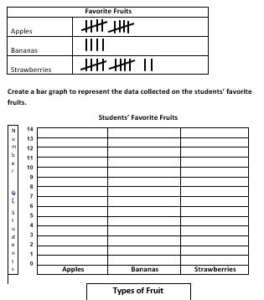MAFS.2.MD.4.10 Draw a picture graph and a bar graph (with single-unit scale) to represent a data set with up to four categories. Solve simple put-together, take-apart, and compare problems using information presented in a bar graph.
Cognitive Complexity Level: 1-Recall
[divider] [/divider] Students are able to…
- Represent data collected by drawing picture and bar graphs.
- Analyze data to draw conclusions, compare, and make generalizations.
- Generate questions related to bar and picture graphs and pose questions to other students regarding data represented. Use precise vocabulary in responses such as: title, key, x and y axis, and labels..
[divider] [/divider] Students are able to…because teachers:
- Give students opportunities to collect data and represent it in picture and bar graphs limited to four categories.
- Use precise vocabulary such as: title, key, the x and y axis, and labels.
- Support students in answering questions related to categories with the least, same, and greatest number of responses.
- Ask questions focused on conclusions, comparisons, and generalizations about data displayed on picture and bar graphs.
- Provide opportunities to discuss data with classmates to build vocabulary and skill in generating appropriate questions.
[divider] [/divider] Questions to ask students:
- Ask: How does a picture graph help you to organize data?
- I can look at the picture graph and easily see which category was the least and which category was the greatest.
- Ask: According to the bar graph, how many students liked “soccer” more than “baseball?”
- 4 more students liked soccer than baseball. I can see how many students liked baseball and then I can count on to the number of students that liked soccer. My answer is 4 because 12 is 4 more than 8.
[divider] [/divider] Additional Resources:
| SoftSchools Online Game: Pictograph Game |
SoftSchools Online Task: Make Your Own Pictograph
| NCES Kids’ Zone: Create a Graph |
Additional in depth content knowledge
[divider] [/divider] Sample Formative Assessment Tasks:
[divider] [/divider] Resources/Tasks to Support Your Child at Home:
Point out bar graphs and picture graphs when you see them at home in magazines or on the news. Ask your child which categories had the most, the least, and how many categories the graph includes.
Creating Bar Graphs and Picture Graphs are explained in this video.
Gather data at your house and create graphs! Your child can make a chore chart and track how often certain chores are completed with a picture or bar graph. Your child can also poll family members on favorites (food, animal, color etc.) and create a graph to display the data.
Use this website to Make Your Own Picture Graph at home.
Students can practice creating their own bar graphs here.
Using breakfast cereal and index cards (for labels), your child can create a graph. Ask questions that require students to add or subtract. For example, “How many people chose red and blue as their favorite color?”
FuzzBugs allows students to sort objects and answer addition and subtraction questions about the graph they created.
